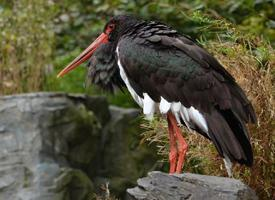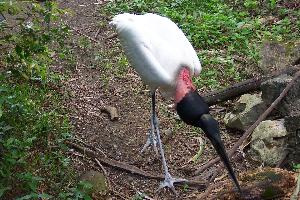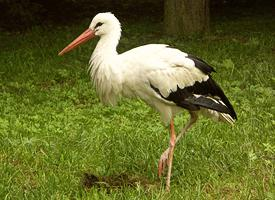
Cunoscut și ca
- Čáp marabu
Greutăți și măsuri
| Înălțime la greabăn | 150 cm |
|---|---|
| Greutate | 9 kg |
| Lungimea anvergurii aripilor | 3,2 m |
Date biologice
| Durata de viață | 40 r |
|---|
Starea de conservare
| Amenințat |
Descrierea animalului
The Marabou stork (Leptoptilos crumeniferus), a member of the Ciconiidae family, is a large wading bird that is native to Africa. It is known for its distinctive appearance and its role as a scavenger in the ecosystem. The Marabou stork can reach impressive heights, standing up to 150 cm (59 inches) tall, with a wingspan that can extend up to 3.7 meters (12 feet), making it one of the largest flying birds in the world.One of the most striking features of the Marabou stork is its bare head and neck, which are devoid of feathers. This adaptation is thought to be a hygienic feature, as it prevents blood and other substances from soiling the bird's plumage while it feeds on carrion. The head is adorned with a cap of wispy, white feathers, and the neck is elongated and appears somewhat deflated, earning the bird the nickname "undertaker bird" due to its somber appearance.
The Marabou stork's bill is long, thick, and conical, perfectly designed for grasping and tearing apart its food. It is typically a yellowish color, with a reddish spot at the base. The bird's eyes are dark and surrounded by a patch of air sacs, which are pink or orange in color and can inflate, playing a role in thermoregulation and possibly in courtship displays.
The body of the Marabou stork is covered in white feathers, while its back and wings are dark grey. During the breeding season, the white feathers can take on a pinkish hue due to secretions from the preen gland. The bird's legs are long and spindly, an adaptation for wading in shallow waters, and are greyish in color. One of the more unusual features of the Marabou stork is the inflatable gular sac at its throat. This pinkish sac can be inflated to assert dominance and attract mates.
Marabou storks are often found in a variety of habitats across sub-Saharan Africa, including savannas, wetlands, and grasslands, as well as human-altered landscapes such as landfills and fishing villages. They are opportunistic feeders, primarily scavenging for carrion, but they will also eat other animals such as fish, frogs, snakes, and small mammals. In some areas, they are known to frequent slaughterhouses and garbage dumps, taking advantage of the readily available food sources.
Socially, Marabou storks can be seen in both large flocks and as solitary individuals. They are colonial breeders, often nesting in groups that can number in the hundreds. Their nests are large structures made of sticks, built high in trees or on cliffs. Both parents take part in incubating the eggs and feeding the young.
The Marabou stork plays a vital role in its ecosystem by consuming carrion and other waste, helping to prevent the spread of diseases. Despite its somewhat macabre appearance and scavenging habits, the Marabou stork is a fascinating creature with a unique niche in the African landscape. It is a species that continues to intrigue bird watchers, biologists, and conservationists alike.
Animale similare
Fotografii noi cu animale
Top 10 animale
- Dolphin gull (Leucophaeus scoresbii)
- Diana monkey (Cercopithecus diana)
- Moustached guenon (Cercopithecus cephus)
- Stone loach (Barbatula barbatula)
- Greek tortoise (Testudo graeca)
- Galápagos tortoise (Geochelone nigra complex)
- Japanese macaque (Macaca fuscata)
- Russian tortoise (Testudo horsfieldii)
- Common flying dragon (Draco volans)
- Galápagos penguin (Spheniscus mendiculus)


